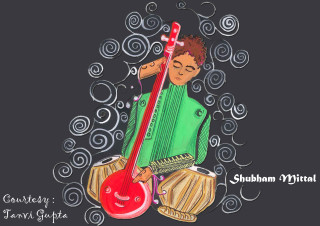 There are many many things about Indian classical music that I would love to talk about. But there are many concepts about which all of you should know before proceeding any further. This article will be based on such terms and definitions which are widely used in Indian classical music.
There are many many things about Indian classical music that I would love to talk about. But there are many concepts about which all of you should know before proceeding any further. This article will be based on such terms and definitions which are widely used in Indian classical music.
Before going on further I would like to tell you that many people objected on the topic of my article saying that it should be Hindustani music and not Indian classical music. As mentioned before I am not talking about Carnatic music therefore the title refers to Hindustani Music only, but still from now on I’ll change the name of my article to ‘Hindustani Music’.
Some of the terms which are frequently used in Hindustani Music are as follows-
1. Naad
2. Alap
3. Sargam
4. Taan
5. Bandish
a. Sthayi
b. Antara
c. Sanchari
d. Aabhog
6. Vilambit
7. Madhyalaya
8. Dhrut
9. Alankar
10. Shruti
11. Andolan
12. Saptak
15. Taar
1. Naad– Any sound note which is used for the purpose of music and has a fixed place or moves about in a fixed periphery is known as a naad. Further naad is divided as follows-
- Aahat Naad– It can be defined as the sound which is produced when 2 things clash with each other or when one thing hits another. For e.g. sound produced while playing a Violin is an Aahat naad as the strings of the violin is struck by a bow to produce sound.
- Anahat Naad– It is the sound which is produced by itself; i.e. without the strike of any other thing is known as an Anahat naad. It can practically not be done by any living being thus it is considered of a spiritual level and we are definitely not getting into that!!
Some other characteristics of naad are-
- Pitch (Uchhapan/Neechapan)
- Intensity (Chhotapan/Badapan)
- Timbre (Jaati/Gun)
- Pitch– I guess you all would know pitch so I’ll not explain that.
- Intensity– Singing the same note but at different volume levels define the intensity of the naad.
- Timbre– It is the quality of a particular sound which helps us differentiate it from other similar sounds. For e.g. a violin and a sitar have different type of sounds; both the sounds have a special timbre of their own which helps us distinguish one sound from the other.
2. Alap– Alap is an improvisation in the bandish to highlight the special features of the raagas. It is a very slow tempo improvisation.
3. Sargam– Named after the 1st four swaras of Hindustani Music (Sa, Re, Ga and Ma). Sargam refers to singing the swaras of a composition instead of the words.
4. Taan– A taan refers to a very fast Sargam sung in between the bandish as an improvisation to the bandish.
5. Bandish is a fixed composition in a particular raag. It is generally performed with a tabla or pakhawaj as instrumental accompanists. Bandish provides a literature element in the music.
A bandish has 4 parts, namely-
a. Sthayi– It is the 1st paragraph sung in the bandish. It gives an introduction about the bandish to the listeners.
b. Antara– It is the 2nd paragraph in the bandish and it gives a broader view of the raag.
c. Sanchari– It is the 3rd paragraph of the bandish and it takes the listeners further into the raag. It is generally sung in ‘dhrupad’ form of singing.
d. Aabhog– It is the 4th and the last paragraph in the bandish and summarises the whole raag and gives the picture of the whole raag in just one paragraph. This paragraph is also mostly sung in ‘dhrupad’ only.
Further a bandish can be sung in different tempos also-
6. Vilambit– This is a very slow and steady tempo. Generally a bandish starts in this tempo
7. Madhyalaya– As the name suggests this tempo is a medium tempo. The bandish after being sung in Vilambit laya slowly comes into a Madhyalaya stage.
8. Dhrut– This is the last stage of the tempo wherein the bandish is sung at a very fast tempo.
9. Alankar– Alankar is a ‘Sanskrit’ word which means Ornament in English. As an ornament is worn to look more attractive, similarly alankars are sung to make the singing more attractive. Alankars can be composed in different ragas or in different taals but the main purpose to sing alankars for a singer is to improve his own knowledge of swaras. Thus it is very important for a singer to keep practising alankars in different ragas and different taals to increase his own knowledge.
10. Shruti– Technically; a shruti is the smallest interval of a pitch which the human ears can detect. There are 22 shrutis in our music. But as these shrutis are so close to each other, these are divided into 7 distinguishable swaras which are Sa Re Ga Ma Pa Dha Ni. Each of these swara is surrounded by some shrutis. The division of the 22 shrutis are as follows-
- Sa- 4
- Re- 3
- Ga- 2
- Ma- 4
- Pa- 4
- Dha- 3
- Ni- 2
Thus totalling to 22 shrutis overall. Shruti is a very elaborative concept and talking about it more will take us into deep discussion which will become an article in itself, so I am discussing only this much about shrutis for the time being.
11. Andolan– Andolan is a general oscillation around a specific swara in classical music wherein the singer touches different sounds around the main swara and also the shrutis in between.
12. Saptak– A Saptak as you all must know is an octave in English. Octave as already told in previous article is a set of 8 swaras; wherein after the 7th swara (Ni) Sa is played again to make it a complete set. There are 3 types of Saptaks-
13. Mandra Saptak– A Saptak of a similar lower pitch is a Mandra Saptak
14. Madhya Saptak– The Saptak which is the base, from where the singer sings is the Madhya Saptak
15. Taar Saptak– A Saptak of a similar higher pitch is a taar Saptak.
I would like to end this article here; but these were only the few basic terms which you all needed to know for the time being, there are several other terms like- Gamak, Meend, Gram, Khatka, Murki, Moorchhana, etc. etc. which will be discussed gradually as per the requirement of time.
Like always, if any of you want to give any suggestions or any feedback; please do so in the comments box below. I’ll surely reply to you. And yes like always, please tell me if you want me to write on a particular topic, I’ll be more than happy to write on that.
Read, Share and give a feedback Asap!!
Thank You
Shubham Mittal

































